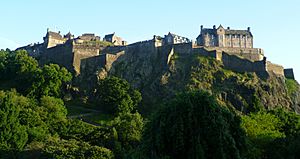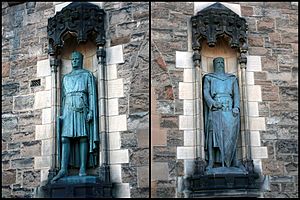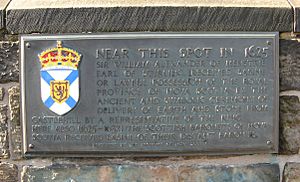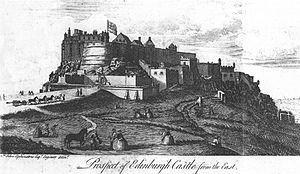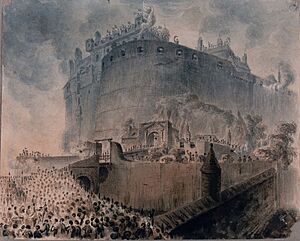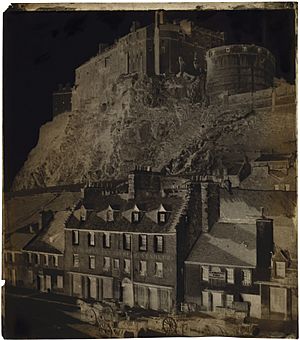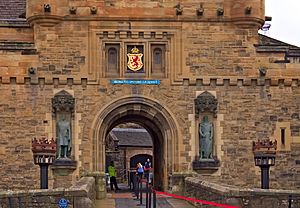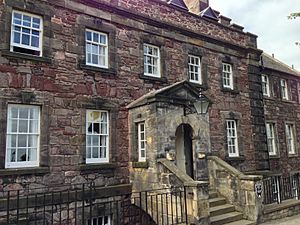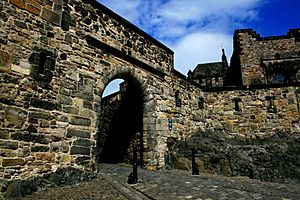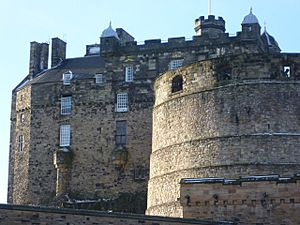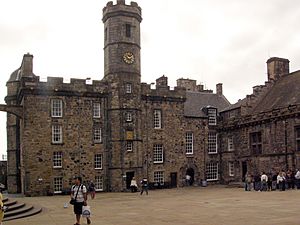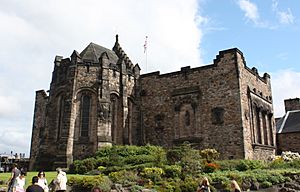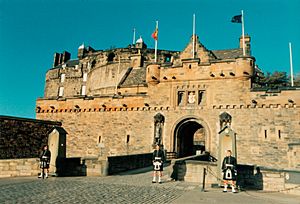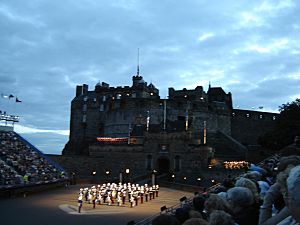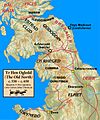Edinburgh Castle facts for kids
Quick facts for kids Edinburgh Castle |
|
|---|---|
| Castlehill, Edinburgh in Scotland | |
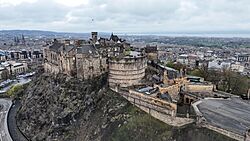
Edinburgh Castle dominates the Old Town.
|
|
 |
|
| Coordinates | 55°56′55″N 3°12′3″W / 55.94861°N 3.20083°W |
| Type | Visitor attraction and British Army regimental headquarters |
| Site information | |
| Owner | Scottish Ministers |
| Operator | Historic Environment Scotland and British Army |
| Open to the public |
Yes |
| Visitor numbers | 2,201,354 (2019) |
| Site history | |
| Built | 11th century through to the 21st century |
| Battles/wars |
|
| Events | Royal Edinburgh Military Tattoo (annual) |
| Garrison information | |
| Current commander |
Major General Bob Bruce |
| Past commanders |
List of governors of Edinburgh Castle |
Edinburgh Castle is a famous historic castle in Edinburgh, Scotland. It sits high up on Castle Rock, a place where people have lived for a very long time, even since the Iron Age. A royal castle has stood here since the 11th century, when King Malcolm III ruled. It was a home for kings and queens until 1633.
Over time, the castle became less of a home and more of a military base by the 17th century. People started to see how important it was to Scotland's history in the 1800s. Since then, many parts of the castle have been repaired and restored.
Edinburgh Castle has played a huge part in Scottish history. It has been a royal palace, a place to store weapons (an arsenal), a treasury for valuable items, a national archive for important papers, and even a mint where coins were made. It was also a prison and a strong military fortress. Today, it protects the Honours of Scotland, which are the Scottish crown jewels.
As one of the most important strongholds in the Kingdom of Scotland, the castle was involved in many battles. These included the Wars of Scottish Independence in the 1300s and the Jacobite rising of 1745. Experts say it has been attacked 26 times in its 1,100-year history. This makes it one of the most besieged places in the world!
Most of the buildings you see today were built after a big attack in 1573 called the Lang Siege. During this siege, many of the old medieval walls were destroyed by cannons. But some older parts remain, like St Margaret's Chapel from the early 1100s, which is the oldest building in Edinburgh. The Royal Palace and the Great Hall from the early 1500s are also still there.
The castle is also home to the Scottish National War Memorial and the National War Museum. Even though it's mostly a tourist spot now, the British Army still uses some parts for ceremonies and administration. It's the main office for the Royal Regiment of Scotland and the Royal Scots Dragoon Guards. It also has museums for these regiments and the Royal Scots.
Historic Environment Scotland looks after the castle. It's Scotland's most popular paid tourist attraction, with over 2.2 million visitors in 2019. More than 70% of tourists visiting Edinburgh come to see the castle. Every year, the Royal Edinburgh Military Tattoo takes place on the castle's Esplanade. This makes the castle a well-known symbol of Edinburgh and Scotland.
Contents
- Castle History: A Journey Through Time
- The Castle Rock: A Natural Fortress
- Early Medieval Times: The Gododdin and Northumbria
- High Middle Ages: Royal Power and Early Buildings
- Wars of Scottish Independence: Battles for Freedom
- David's Tower and the 1400s
- The Lang Siege: A Long Battle (1571–1573)
- Changes and Conflicts: 1600s and 1700s
- From Fortress to National Monument: 1800s to Today
- Exploring Edinburgh Castle
- Edinburgh Castle Today
- Images for kids
- See also
Castle History: A Journey Through Time
The Castle Rock: A Natural Fortress
How the Rock Was Formed
The castle sits on top of an extinct volcano. This volcano erupted about 350 million years ago. The hard rock left behind, called dolerite, resisted the movement of glaciers. This created a special landform called a "crag and tail." The castle is on the "crag" (the rocky peak), and the Royal Mile (a famous street) stretches along the "tail" (the gentler slope).
The top of Castle Rock is about 130 meters (426 feet) above sea level. It has steep cliffs on three sides, making it very hard to attack. The only easy way up is from the east, where the town is. This natural defense was a big advantage. However, the hard rock made it difficult to get water. Even with a deep well, the castle often ran out of water during dry times or sieges.
Early People on the Rock
We don't know exactly when people first lived on Castle Rock. Ancient maps from the 2nd century AD show a settlement called "Alauna," meaning "rock place," which might have been here. Some old stories say a legendary king named Ebraucus built a castle here around 989 BC. This castle was sometimes called the "Maidens' Castle." No one knows for sure why it had this name. It might have been because it was never captured, or perhaps it was linked to old legends about nine maidens.
Archaeologists found signs that people lived here in the late Bronze Age or early Iron Age. This means Castle Rock might be the longest continuously inhabited place in Scotland! Later, during the Iron Age, there was likely a fortified village, or hillfort, on the rock. They also found Roman items, showing that people living here traded with the Romans.
Early Medieval Times: The Gododdin and Northumbria
The castle isn't mentioned again in history until around AD 600. An old Welsh poem called Y Gododdin talks about "Din Eidyn," which means "the stronghold of Eidyn." This is thought to be Castle Rock. The poem tells a sad story of warriors who fought bravely but were defeated by the Angles.
In 638, the Angles, led by Oswald of Northumbria, attacked and captured "Etin." The area around Edinburgh then became part of the Kingdom of Northumbria. Later, in the 10th century, this land became part of Scotland.
High Middle Ages: Royal Power and Early Buildings
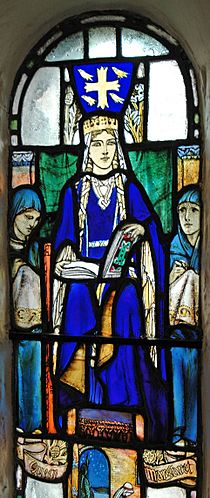
The first written record of a castle in Edinburgh is from the late 1000s. It mentions Queen Margaret living at the "Castle of Maidens" when her husband, King Malcolm III, died in 1093. She died there a few days later. During the time of Malcolm III and his sons, Edinburgh Castle became a very important royal center in Scotland.
King David I (ruled 1124–1153) made Edinburgh a key place for royal power. He held important meetings at the castle. The buildings then were probably made of wood. However, two stone buildings existed in the 12th century. One is St. Margaret's Chapel, which you can still see today. It's believed to be the oldest building in Edinburgh.
In 1174, King William "the Lion" was captured by the English. To get free, he had to give Edinburgh Castle and other castles to the English King, Henry II. The English held the castle for 12 years. By the end of the 1100s, Edinburgh Castle was where Scotland kept its most important official papers.
Wars of Scottish Independence: Battles for Freedom
In 1286, King Alexander III died, and the Scottish throne was empty. Edward I of England tried to take control of Scotland. In 1296, he invaded, and Edinburgh Castle quickly fell to the English after a three-day attack. Edward moved many Scottish treasures and records to England.
However, England's control weakened after Edward I died in 1307. On March 14, 1314, Thomas Randolph, 1st Earl of Moray, led a surprise night attack and recaptured the castle for Scotland. Robert the Bruce then ordered the castle to be destroyed so the English couldn't use it again. A few months later, Bruce's army won the Battle of Bannockburn.
The English reoccupied the castle in 1335 during the Second War of Scottish Independence. But in 1341, William Douglas, Lord of Liddesdale, led another clever attack. His men pretended to be merchants bringing supplies. They stopped their cart in the entrance, preventing the gates from closing. A larger Scottish force then rushed in and retook the castle, killing the English soldiers.
David's Tower and the 1400s
After the Wars of Independence ended in 1357, King David II rebuilt Edinburgh Castle. It became his main government seat. He started building David's Tower around 1367, but he died before it was finished. His successor, Robert II, completed it in the 1370s. This tower was located where the Half Moon Battery is today.
In the early 1400s, Henry IV tried to besiege the castle but left because he ran out of supplies. In 1440, a sad event known as the "Black Dinner" happened here. Two young noble brothers, William and David Douglas, were invited to the castle by Sir William Crichton. They were then falsely accused and executed in front of the young King James II.
Throughout the 1400s, the castle became an important place for making weapons. The famous "great bombard" cannon, Mons Meg, arrived in Edinburgh in 1457. By 1498, skilled workers were making bronze cannons here.
Around the end of the 15th century, King James IV built the Palace of Holyroodhouse as his main home in Edinburgh. This meant the castle was used less as a royal residence. However, James IV did build the Great Hall, which was finished in the early 1500s.
The Lang Siege: A Long Battle (1571–1573)
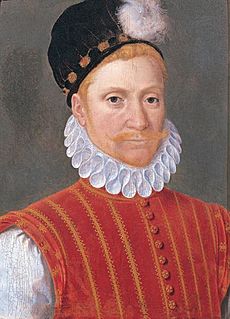
After King James IV died in battle in 1513, Scotland prepared for an English attack. New defenses were added to the castle. Later, King James V and his daughter, Mary, Queen of Scots, were brought to the castle for safety during English invasions.
In 1566, Mary, Queen of Scots, gave birth to her son, James, in a small room in the castle's palace. Mary's reign was difficult, and she was forced to give up her throne. A civil war then broke out between her supporters and those who supported her infant son, King James VI.
In 1571, Sir William Kirkcaldy of Grange took control of Edinburgh Castle for Queen Mary. This led to a two-year standoff known as the "Lang Siege" (meaning "long siege"). Grange's forces in the castle bombarded the town, and the King's forces tried to cut off supplies.
Eventually, Elizabeth I of England sent about 1,000 English troops and 27 cannons to help the King's side. On May 17, 1573, the English began a massive bombardment. Over 12 days, they fired about 3,000 shots at the castle. David's Tower and the Constable's Tower collapsed.
With their defenses destroyed and water running out, Grange's garrison threatened to mutiny. He surrendered the castle to the English on May 28, 1573. Grange and some of his supporters were later executed.
Changes and Conflicts: 1600s and 1700s
After the Lang Siege, the castle was largely rebuilt. The Half Moon Battery, a large artillery defense, was constructed. In 1603, King James VI became King of England as well as Scotland. He left Edinburgh, and the palace in the castle was used less.
In 1621, King James gave land in North America to Sir William Alexander. This land was called Nova Scotia ("New Scotland"). To help people settle there, a special title, the Baronetage of Nova Scotia, was created. People receiving this title could officially claim their land at Edinburgh Castle, making it a symbolic link to the new territory.
King Charles I visited the castle only once in 1633. This was the last time a reigning monarch lived in the castle. In the 1600s, civil wars broke out in Britain. The castle was captured by Scottish Covenanters and later by Oliver Cromwell's English forces, suffering more damage.
Jacobite Rebellions and Prisoners
After 1660, the castle became a permanent military base. It was used as a prison for important political figures. In 1689, the castle was besieged again during the Glorious Revolution. The Governor, a supporter of the old king, eventually surrendered after three months.
The castle was almost captured by Jacobite rebels in 1715. They tried to climb the walls with rope ladders, but the attempt failed. In the 1720s and 1730s, the castle's defenses were greatly strengthened with new artillery batteries.
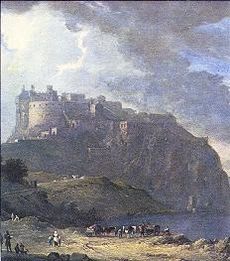
The last time the castle saw military action was during the Jacobite Rising of 1745. The Jacobite army captured Edinburgh, but the castle's Deputy Governor refused to surrender. The Jacobites tried to block the castle, but the castle's cannons fired on the town, forcing them to stop.
For the next century, the castle's vaults were used to hold prisoners of war. These included soldiers from the Seven Years' War, the American War of Independence, and the Napoleonic Wars. New buildings like powder magazines and barracks were built during this time.
From Fortress to National Monument: 1800s to Today
In 1811, 49 prisoners of war escaped from the castle. This showed that the vaults were no longer good for prisons. By 1814, the castle stopped being a prison and slowly began to become a national monument.
In 1818, Sir Walter Scott found the Honours of Scotland (the Scottish crown jewels) in a sealed room. They had been hidden since 1707. These jewels were then put on public display. In 1822, King George IV visited Edinburgh, becoming the first king to visit the castle since 1651. The famous cannon, Mons Meg, was returned to the castle in 1829.
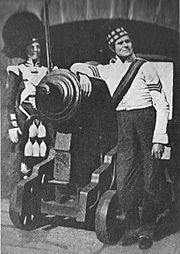
St Margaret's Chapel was "rediscovered" in 1845 after being used as a storage room. In the 1880s, the Great Hall was restored after being used as a barracks for many years. A new Gatehouse was also built.
In 1905, the castle's care was moved from the War Office to the Office of Works. The military garrison left in 1923, moving to Redford Barracks. However, the castle was used as a prison again during both the First and Second World Wars.
Today, Historic Environment Scotland looks after the castle. It was named a World Heritage Site by UNESCO in 1995. The castle is a key part of Edinburgh's Old and New Towns, which are famous around the world.
Exploring Edinburgh Castle
Edinburgh Castle sits at the top of the Royal Mile, at the western end of Edinburgh's Old Town. The Castle Rock provides natural defenses with steep cliffs. The only easy way to reach the castle is from the east, where the town is. Because of this, many gates and defenses protect the path to the top.
Outer Defenses: The Esplanade and Gatehouse
In front of the castle is a large, sloping area called the Esplanade. This was once a 16th-century fortification. Today, it's a parade ground laid out in 1753. The famous Edinburgh Military Tattoo takes place here every August.
The main Gatehouse at the top of the Esplanade was built in 1888. It has statues of Scottish heroes Robert the Bruce and William Wallace. Above the gate, you can see the Latin motto Nemo me impune lacessit, which means "No one provokes me with impunity." A dry ditch in front of the entrance was finished in 1742. Inside the Gatehouse are offices, and a ticket office was added in 2008.
Portcullis Gate and Argyle Tower
The Portcullis Gate was started after the Lang Siege in the 1570s. It replaced an older tower that was destroyed. In the late 1800s, a new tower called the Argyle Tower was built above the original Portcullis Gate. It was named after the 9th Earl of Argyll, who was imprisoned there.
Just inside this gate is the Argyle Battery, which looks over Princes Street. To the west is Mills Mount Battery, where the One O'Clock Gun is fired. Below these defenses is the Wellhouse Tower, built in 1362. It guarded St. Margaret's Well, an important water source for the castle.
Military Buildings: Barracks and Museums
The northern and western parts of the castle have many military buildings from the 1700s. Near Mills Mount are old cart sheds, now used as tea rooms. The Governor's House, built in 1742, was once home to the Governor and other officers. Today, it's an officers' mess and the Governor's office.
South of the Governor's House are the New Barracks, finished in 1799. They could house 600 soldiers. Today, they are home to the main offices of the Royal Regiment of Scotland and the Royal Scots Dragoon Guards. They also house the Royal Scots Dragoon Guards Museum. Nearby is the Regimental Museum of the Royal Scots. The military prison, built in 1842, was last used in 1923.
National War Museum of Scotland
West of the Governor's House is the National War Museum. It used to be a military hospital. This museum, part of the National Museums of Scotland, tells the story of Scotland's military history over the last 400 years. It displays uniforms, medals, weapons, and explains the many wars Scottish soldiers have fought in.
The Upper Ward: Chapel, Cannon, and Crown Square
The Upper Ward is the highest part of Castle Rock. You enter it through Foog's Gate. The name might come from the thick sea-fogs, called haars, that often cover Edinburgh. Near the gates are large water tanks and a shop.
The very top of the rock has St. Margaret's Chapel and the huge 15th-century cannon, Mons Meg. Below this area is a small 19th-century Dogs' Cemetery, where soldiers buried their pet mascots.
St. Margaret's Chapel
This is the oldest building in Edinburgh Castle and in the city itself. It was built by King David I in the 1100s as a private chapel for the royal family. He dedicated it to his mother, Saint Margaret of Scotland. The chapel survived the destruction of 1314 and was used to store gunpowder for a long time. It was "rediscovered" in 1845 and restored. Today, it's still used for special religious events like weddings.
Mons Meg: The Giant Cannon
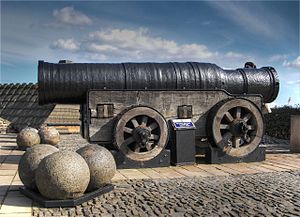
Mons Meg is a massive 15th-century siege gun. It was made in Flanders in 1449 and given as a gift to King James II in 1457. This cannon weighs about 13,000 pounds (5,900 kg)! Some of its huge cannonballs, each weighing around 330 pounds (150 kg), are displayed next to it.
In 1558, Mons Meg was fired to celebrate the marriage of Mary, Queen of Scots. One of its cannonballs landed two miles away! The gun stopped working in 1681 when its barrel burst while firing a salute.
Half Moon Battery and David's Tower
The Half Moon Battery is a very noticeable part of the castle on the east side. It was built between 1573 and 1588 after the Lang Siege. It was constructed around the ruins of David's Tower, which still exists underneath it. You can see parts of David's Tower inside the battery, showing the damage from the 1573 bombardment.
Crown Square: The Heart of the Castle
Crown Square, also called Palace Yard, was created in the 1400s. It's the main courtyard of the castle. Large stone vaults were built to create a flat area for the square. These vaults were used as a state prison until the 1800s. The Royal Palace, the Great Hall, the Queen Anne Building, and the Scottish National War Memorial surround the square.
Royal Palace
The Royal Palace contains the old royal apartments where Scottish monarchs lived. It was started in the mid-1400s. It was greatly updated for King James VI's visit in 1617. On the ground floor is the King's Dining Room and the Birth Chamber, where James VI was born to Mary, Queen of Scots, in 1566.
Upstairs is the Crown Room, built in 1615. It holds the Honours of Scotland: the crown, scepter, and sword of state. The Stone of Scone, used for crowning Scottish monarchs, has been kept here since its return to Scotland in 1996.
Great Hall
The Great Hall is 29 meters (95 feet) long and 12.5 meters (41 feet) wide. It was the main place for important state meetings in the castle. It was likely finished in the early 1500s during the reign of King James IV. It has a beautiful carved wooden roof.
After Oliver Cromwell took the castle in 1650, the Great Hall became a barracks for soldiers. It was later a military hospital until 1897. Today, it's sometimes used for special ceremonies.
Queen Anne Building
This building is named after Queen Anne. It was built in 1708. It used to provide housing for officers. After the Army left, it became a museum. Today, it has rooms for events and an education center.
Scottish National War Memorial
The Scottish National War Memorial is in a converted barracks building on the north side of Crown Square. It was designed by Sir Robert Lorimer and opened on July 14, 1927. The memorial honors Scottish soldiers who died in the two World Wars and other conflicts.
Inside, there are monuments to different regiments. Stained-glass windows add to its beauty. A sealed casket on the altar holds the names of over 147,000 soldiers killed in the First World War. More names have been added for later conflicts.
Edinburgh Castle Today
Edinburgh Castle is owned by the Scottish Government. Historic Environment Scotland manages most of it. However, the Army still uses some areas, like the New Barracks and military museums.
A Popular Tourist Spot
Historic Environment Scotland works to make the castle a great place for tourists while also protecting its history. Edinburgh Castle is Scotland's most popular paid visitor attraction. It had over 2.2 million visitors in 2019. The castle has cafes, shops, and many historical displays. An education center offers events for schools, sometimes with actors in historical costumes.
The Castle's Military Role
Even though the main Army garrison moved out in 1923, the castle still has strong ties to the military. It's one of the few old castles in Britain that still has a military presence. This is mostly for ceremonies and administration. Soldiers guard the Honours of Scotland, and armed sentries stand watch at the Gatehouse. The role of Governor of Edinburgh Castle is now an honorary title.
The Royal Edinburgh Military Tattoo
Every August, a series of performances called the Royal Edinburgh Military Tattoo takes place on the Esplanade. It started in 1950 and features a parade of massed pipes and drums from Scottish regiments. Performers from all over the world also take part. The highlight is a lone piper playing on the castle battlements. The Tattoo attracts about 217,000 people each year and is broadcast to millions worldwide.
The One O'Clock Gun
The One O'Clock Gun is a special time signal. It's fired every day at exactly one p.m., except on Sundays, Good Friday, and Christmas Day. It started in 1861 to help ships in Leith harbor know the correct time. It was especially useful when fog made it impossible to see the 'Time Ball' on the Nelson Monument.
The original gun was an 18-pound cannon. It was replaced over the years, and the current gun is an L118 Light Gun, used since 2001. The gun is now fired from Mill's Mount Battery. Even though it's no longer needed for its original purpose, the ceremony is a very popular tourist attraction.
A Symbol of Edinburgh
The castle has become a famous symbol of Edinburgh and Scotland. You can see a stylized version of it on the coats of arms of the City of Edinburgh Council and the University of Edinburgh. It also appears on the badges of sports teams and local newspapers.
The castle is featured on Scottish banknotes. Since 1987, it has been on the back of £1 notes from the Royal Bank of Scotland. It also appears on £10 notes from the Clydesdale Bank since 2009. The castle is a central point for the annual fireworks displays during Edinburgh's Hogmanay (New Year) celebrations and at the end of the Edinburgh Festival in the summer.
Images for kids
See also
 In Spanish: Castillo de Edimburgo para niños
In Spanish: Castillo de Edimburgo para niños




